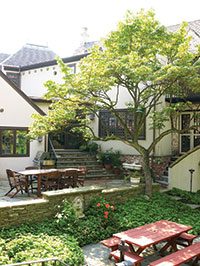

When Michele Waller and her husband, Keith, first saw this home in Glen Rock, they knew they had stumbled upon something special. “I’d always liked Tudors, but this wasn’t even that. It was more like a castle,” says Michele. Little did they know when they bought the French Norman-style house twelve years ago that it had been the home of noted New Jersey architect Carl Kemm Loven.
 Although more than 500 of Loven’s Norman Revival homes dot the landscape of northern New Jersey, the architect himself would have most likely fallen into obscurity had it not been for Glen Rock town historian Nancy Atkins Peck. Long an admirer of the fairy tale-like homes—adorned with turrets, dovecotes, leaded-glass windows, and hand-forged hardware—Peck decided to find out more about the man and his work. She became a sleuth of sorts, tracking down his designs around the state. Peck became so entranced—and so committed to keeping Loven’s work from anonymity—she published a booklet, Carl Kemm Loven: Designer of Dreams, which was recently honored by the Architects League of Northern New Jersey, a section of the New Jersey chapter of the American Institute of Architects.
Although more than 500 of Loven’s Norman Revival homes dot the landscape of northern New Jersey, the architect himself would have most likely fallen into obscurity had it not been for Glen Rock town historian Nancy Atkins Peck. Long an admirer of the fairy tale-like homes—adorned with turrets, dovecotes, leaded-glass windows, and hand-forged hardware—Peck decided to find out more about the man and his work. She became a sleuth of sorts, tracking down his designs around the state. Peck became so entranced—and so committed to keeping Loven’s work from anonymity—she published a booklet, Carl Kemm Loven: Designer of Dreams, which was recently honored by the Architects League of Northern New Jersey, a section of the New Jersey chapter of the American Institute of Architects.
Of all his designs, the most distinctive is the house where Michele and Keith are now raising their three children. It’s the house Loven lived and worked in most of his career. The name of the house, which is carved on a sign above the front door, is Manoir Roche Vallon (French for “house in the valley of the rock”). Its gables and turrets exhibit Loven’s talent as an artist and architect, as well as his passion for Norman architecture, according to Peck. “Loven designed in many styles,” she says, “but this house has all the special qualities at once.”
 Having fallen into disrepair after years of neglect (Loven died in 1965), the house needed restoration—a project the Wallers didn’t even start for several years after moving in. “We did a lot of research in the beginning to keep it pure,” says Michele. Aside from restoring, the Wallers wanted to expand the kitchen and add two bedrooms. The biggest challenge: Tangled rooflines were so complicated the Wallers turned to Glen Rock architects Xiomara Paredes and Glenn Grube of Paredes-Grube Architecture to figure things out. The firm, which specializes in old homes, has been involved in nearly twenty Loven restorations. “The funny thing is, previously I had worked on these homes but I didn’t know they were his,” says Paredes. “Every house is so different. His designs are very versatile.”
Having fallen into disrepair after years of neglect (Loven died in 1965), the house needed restoration—a project the Wallers didn’t even start for several years after moving in. “We did a lot of research in the beginning to keep it pure,” says Michele. Aside from restoring, the Wallers wanted to expand the kitchen and add two bedrooms. The biggest challenge: Tangled rooflines were so complicated the Wallers turned to Glen Rock architects Xiomara Paredes and Glenn Grube of Paredes-Grube Architecture to figure things out. The firm, which specializes in old homes, has been involved in nearly twenty Loven restorations. “The funny thing is, previously I had worked on these homes but I didn’t know they were his,” says Paredes. “Every house is so different. His designs are very versatile.”
The Wallers, the architects, and local builder Jeff Tynik tackled the project as a team. “Once we solved the problem of the rooflines, everything fell into place,” says Paredes. “The house really told us what it wanted to be. Everything came naturally after that.”
Original materials were used as often as possible: Old wood trim was restored, stained-glass windows were remounted, worn brick was reclaimed, old chestnut floors were refinished and re-installed. The Wallers tracked down the source of the original ceramic roof tiles to use on the addition, and Michele herself cast new cement gargoyles to replicate the original exterior ones. “I could only make three at a time,” she says, “and they weren’t drying fast enough. That slowed us down a bit.”
 The result—although everyone stresses that the project is not yet complete—is a thoroughly unique house that has survived and flourished over time. “The kids say, ‘don’t ever sell this house’,” says Michele. “They want it forever.”
The result—although everyone stresses that the project is not yet complete—is a thoroughly unique house that has survived and flourished over time. “The kids say, ‘don’t ever sell this house’,” says Michele. “They want it forever.”
Timely tips
Homeowner Michele Waller and architect Xiomara Paredes offer these tips for restoring an old home so it remains true to its roots.
• Understand the style: Familiarize yourself with the key features of your home, says Paredes, before you start working with an architect.
• Research extensively: Home magazines and books are a great place to start. Clip pictures and start a file. Says Waller, “I found Period Homes magazine to be very helpful.”
• Hire people you trust: The most important thing is to work with an architect and contractor who will stay true to the style of the home while making it fit your needs, emphasizes Waller. Your contractor should have experience with old homes and be able to work with non-standard materials.
• Search online: A wealth of materials are available. The Internet is a great place to get ideas, comparison shop, and purchase materials, often less expensively. “I found many of my building and decorating supplies online, including handmade terra cotta tile, rustic interior doors, iron lighting, and kitchen and bath hardware,” says Waller.
 • Be patient and don’t give up: Working with an old home can be very challenging, and it requires a lot of patience. “You will find the right thing,” says Paredes, “but don’t rush it.”
• Be patient and don’t give up: Working with an old home can be very challenging, and it requires a lot of patience. “You will find the right thing,” says Paredes, “but don’t rush it.”
• Salvage and reuse materials: Original trim, doors, hardware, and more can be utilized as you put the house back together.
• Embrace your home’s uniqueness: An old house doesn’t necessarily have the convenient layout or updated materials of a new one, but then, says Paredes, “that’s the beauty of it.”
Nancy Peck’s award-winning pamphlet on Carl Kemm Loven is online at glenrockhistory.org, and may be purchased from the Glen Rock, Ridgewood, Midland Park, and Ho-Ho-Kus public libraries for a small fee.
